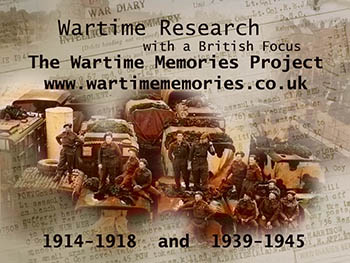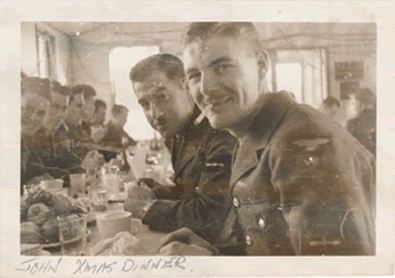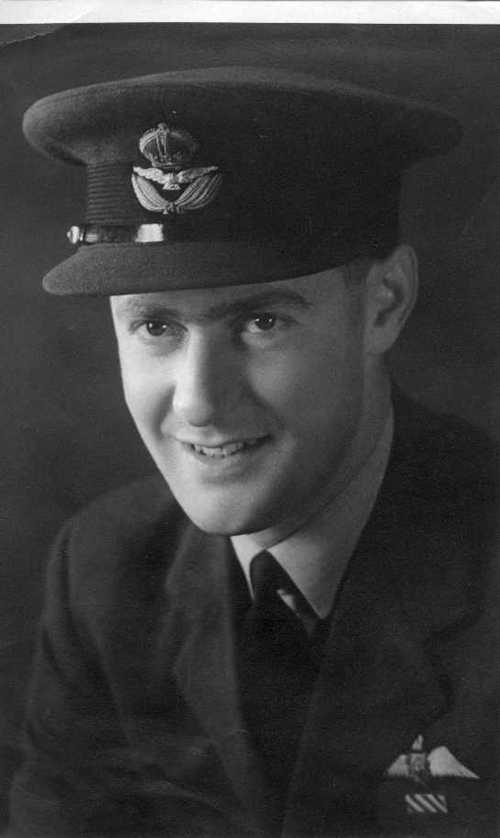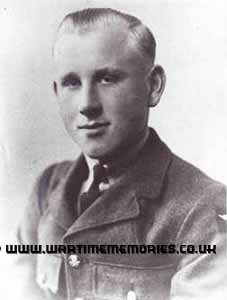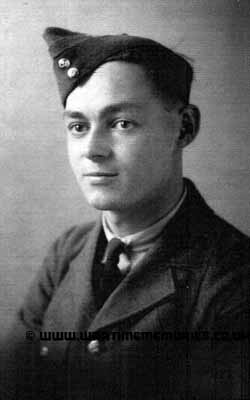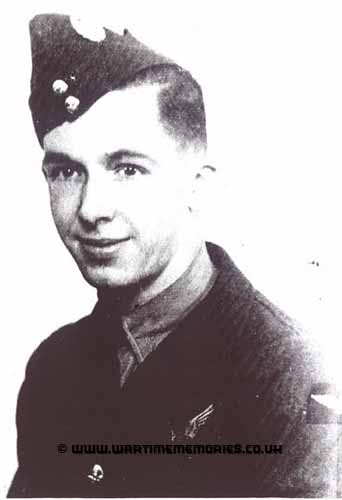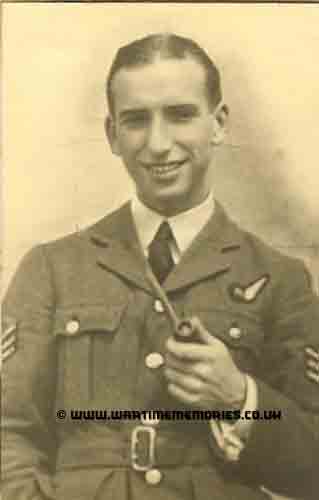|
|
|
18th May 1942On this day:
If you can provide any additional information, please add it here.
|
Remembering those who died this day.
- Booth Neville George Richardson. Flt Lt (d.18th May 1942)
- Butterworth John Bernard. Sgt. (d.18th May 1942)
- Hall John Charles. Sqn. Ldr. (d.18th May 1942)
- Maycock Ronald. Sgt. (d.18th May 1942)
- Nicholson Robert Nick. Sgt. (d.18th May 1942)
- Ryan John Patrick. F/O (d.18th May 1942)
- Sharp Frank Leslie. Sgt. (d.18th May 1942)
- Spriggs Anthony. Sgt. (d.18th May 1942)
The names on this list have been submitted by relatives, friends, neighbours and others who wish to remember them, if you have any names to add or any recollections or photos of those listed,
please
Add a Name to this List
|
|
|
The Wartime Memories Project is the original WW1 and WW2 commemoration website.
Announcements

- 1st of September 2024 marks 25 years since the launch of the Wartime Memories Project. Thanks to everyone who has supported us over this time.
- The Wartime Memories Project has been running for 25 years. If you would like to support us, a donation, no matter how small, would be much appreciated, annually we need to raise enough funds to pay for our web hosting and admin or this site will vanish from the web.
- 16th Jan 2025 - Please note we currently have a huge backlog of submitted material, our volunteers are working through this as quickly as possible and all names, stories and photos will be added to the site. If you have already submitted a story to the site and your UID reference number is higher than
265273 your information is still in the queue, please do not resubmit, we are working through them as quickly as possible.
- Looking for help with Family History Research?
Please read our Family History FAQs
- The free to access section of The Wartime Memories Project website is run by volunteers and funded by donations from our visitors. If the information here has been helpful or you have enjoyed reaching the stories please conside making a donation, no matter how small, would be much appreciated, annually we need to raise enough funds to pay for our web hosting or this site will vanish from the web.
If you enjoy this site
please consider making a donation.
Want to find out more about your relative's service? Want to know what life was like during the War? Our
Library contains an ever growing number diary entries, personal letters and other documents, most transcribed into plain text. |
|
Wanted: Digital copies of Group photographs, Scrapbooks, Autograph books, photo albums, newspaper clippings, letters, postcards and ephemera relating to WW2. We would like to obtain digital copies of any documents or photographs relating to WW2 you may have at home. If you have any unwanted
photographs, documents or items from the First or Second World War, please do not destroy them.
The Wartime Memories Project will give them a good home and ensure that they are used for educational purposes. Please get in touch for the postal address, do not sent them to our PO Box as packages are not accepted.
World War 1 One ww1 wwII second 1939 1945 battalion
Did you know? We also have a section on The Great War. and a
Timecapsule to preserve stories from other conflicts for future generations.
|
|
Want to know more about the 18th of May 1942? There are:7 items tagged 18th of May 1942 available in our Library There are:7 items tagged 18th of May 1942 available in our Library 
These include information on officers, regimental histories, letters, diary entries, personal accounts and information about actions during the Second World War. |
|
Stories from 18th May 1942
|
Sgt. Donald John "" Jeffs. Royal Air Force, pilot 15 Sqd. On 18 May 1942, a young airman was thrown out of a Stirling bomber as it crashed into a Danish forest following a one-sided altercation with several anti-aircraft guns and the massive firepower of the battle cruiser Prinz Eugen. The remarkable escape of Sgt Don Jeffs from the wreckage that claimed the lives of his fellow crewmen, and his subsequent incarceration by the Germans in Stalag 8b POW camp
The evening of May 17th 1942 was clear and cloudless, but with no moon to speak of. That was why it had been chosen, less chance of being seen. The nine airmen walked over to the huge aircraft that would shortly be their only friend over enemy skies; a role it had served many times and with distinction. They had just completed their pre-flight briefing, the officers going over the mission details and maps of the target area, the enlisted men smoking and chatting about the forthcoming evening. As usual the crew were well aware of both the target and the outline flight plan before the skipper had briefed them. Such was the way in squadron's all over England in 1942.
The crew climbed aboard using their various entry doors, and quietly and efficiently moved to their assigned takeoff positions. Jokes were exchanged, the recognised method of ignoring what was shortly to come. The second pilot answered an unheard message from the control tower and a few glances were exchanged. The voice was a new one to them, and any change in routine on a mission always caused some concerns for the highly superstitious bomber crews. Flight Lieutenant Neville Booth was a friend of the skipper, and therefore made welcome by the crew, but he had been added at the last minute as an RAF observer for the mission, and no-one liked last minute changes. They often meant trouble.
The two pilots began their pre-flight instrument checks, and the wireless operator Don Jeffs contacted the tower to check his radio. The navigator John Ryan, with the new rookie Ronnie Maycock alongside him, opened his leather case and took out his maps while the gunners Butterworth, Nicholson, and Sharpe, silently prepared the massive machine guns for the evening's mission. All round the aircraft airmen were preparing for their next mission. It was 21.40 hrs as the four massive Hercules engines started up, each producing nearly 1600 horsepower. The vibrations ran the length of the Stirling, call sign LS-F (for Freddie) and through the men inside it's belly. 'Men' was perhaps too easy a term to use given the times they were in. The Skipper, John Hall, who was a veritable twenty-four would have been considered old by the standards of warfare. So many proud young sons had perished long before reaching their twenties.
Squadron Leader John Hall came over the intercom, 'crew get ready for takeoff'. Apart from the co-pilot alongside him, his friend Neville Booth, there were smiles all round from the rest of the established Reply crew. They were already veterans of many flights and had been 'ready' from well before the engines were fired up, but the skipper liked to be thorough which was why he was so liked and admired by the men who flew with him. This was a friendly crew, well used to living in close company both on and off the big bomber. All the crew had long since checked and rechecked their instruments and guns, knowing they would need the former to get where they were going, and in all probability the latter to be able to get home safely. The skipper and his co-pilot ran over the final instrument checks, while Tony Spriggs the engineer confirmed the bomber had all necessary oil and hydraulic pressures. Soon after they received their clearance from the tower, and started their slow approach to the runway.
The pilot lined the aircraft up along the designated strip, its huge engines throbbing with urgency. The two young men in the cockpit looked at each other and gave a simple nod, it was enough. They opened the throttles and W7531 began it's long deliberate lope up the runway at RAF Wyton fifty miles north of London. The huge aircraft gained speed at an impossibly slow rate and inside everything was vibrating and shrieking in protest, but as the Stirling's ground speed increased and Squadron Leader Hall pulled back on his stick, the huge beast lifted it's nose and rose slowly skywards. The fully laden takeoff weight of some 32 tons required maximum thrust from the engines, and vast plumes of black smoke accompanied the roar bellowing from the exhausts as the famous 'MacRobert's Reply' went to war.
The mission that night was to lay 6 tons of 'vegetable' mines in 'Daffodil', the code name for an area off the Norwegian coast called Ørersund. The Stirling was to fly north east to Malmo in Sweden and then reduce altitude to a few hundred feet and fly due west towards the Jutland peninsula of Denmark to commence the bombing run into the Sound. The outward leg went smoothly due to the masterly skills of the Kiwi navigator John 'Buck' Ryan who had joined MacRobert's Reply from the Canadian Royal Air Force. Buck had a trainee navigator with him on that flight, one Sgt Ronnie Maycock later to be known as the 'missing man'. The crew enjoyed the usual in-flight entertainment of local radio stations tuned into the aircraft intercom by the wireless operator Sgt Donald 'Duncan' Jeffs. As they neared the enemy coastline Sgt Jeffs cut the radio transmissions and they maintained radio silence to reduce the possibility of detection. As they flew over Malmo they received the customary burst of blank anti-aircraft fire, accompanied by the crossed searchlights indicating their target destination. For a neutral country, Sweden always made sure the allied bombers received as much assistance as possible. As they began to turn southwest, Squadron Leader Hall pushed the stick forward and reduced speed to commence the bomb run.
RAF intelligence had indicated that the only hazards were the batteries on the Danish coast, but the MacRobert's Reply and it's gallant company intended to be flying back home well before that. However, as they descended to 200 feet and prepared to open the bomb bay doors, the roar of heavy guns and the piercing crash of shrapnel exploding beside the aircraft shattered the peaceful evening. The intelligence report, while correct about the shore batteries, had omitted to include the huge cruiser 'Prince Eugen' working its way up the Great Belt in the Sound and now using its anti-aircraft guns at an impossibly large target just 200 feet off the water's surface. The plane shuddered as the port engine took a direct hit and burst into flames. 'Skipper the port engines on fire' echoed several of the crew together, but Squadron Leader Hall was having his own problems trying to gain steerage and altitude. As the aircraft somehow continued to defy the laws of gravity, it remained fixed on a westerly heading - towards the Danish islands. The crew were desperately trying to jettison the six tons of sea mines but the control mechanism for the bay doors had been damaged by the shelling and refused to play it's part as the huge bomber struggled to stay in the air. 'Skipper, were coming up to Funnen, watch out for the Little Belt bridge up ahead; we must try to go round' shouted Don Jeffs as he surveyed the coastline through the huge fire streaking past the window next to his wireless operator's chair on the port side. 'Yeah Duncan I know, but I've no controls' the skipper responded 'I'm going to try to get to the North Sea so we can ditch her if we need to'.
Immediately after the verbal exchange the anti-aircraft batteries on the bridge saw the huge target lit up by the fires and lumbering toward them. As the spotlights picked up W7531 and the crew saw the shadows reflecting from the intense glare in the windows, and unnatural silence sat heavily in the plane as their destiny began to take shape. The first barrage of 20mm shells from the guns on the bridge found it's mark and the MacRobert's Reply is hit again and again. The plane turned violently to starboard and dived earthwards, her gallant fight for survival all but over. As the huge aircraft descends it ploughs through the spruce tress of the Mathilde plantation and crashes with a colossal explosion that tears a massive rock from the ground and lays waste to over an acre of prime forest. At 02.10am on the morning of 18 May 1942, the crew of the MacRobert's Reply proudly, and with honour, fly their last mission in W7531 LS-F (for Freddie).
The German military arrived at the crash scene at 02.30hrs and quickly enlisted the 'help' of the local fire service that had already arrived at the site under the supervision of the Chief Fire Officer Jensen. C/O Jensen organised his teams into two parties. The first would fight the fire raging around the wreckage and threatening the surrounding forest. The second 'Falck' (salvage) team would find anything at the crash scene that could identify the plane and its crew, and would remove the bodies for later burial. The first fire crew fought the fire for two hours before the salvage crew were ready to move in. Immediately the local residents formed a human blockade to prevent the Germans from moving onto the crash site; a galant gesture of defiance and tribute to the fallen allies. A standoff ensued for many tense minutes. The German commanding officer ordered weapons to be readied and issued instructions for the locals to depart otherwise they would be shot. Reluctantly they were forced to retreat, but one man still refused and was taken into custody, later to spend the rest of the war in a prison camp for his defiance.
The Germans knew the plane downed was a Stirling and their salvage crew had collected a total of 7 'dog tags' from the remains of the young allied airmen. It was well known that a Stirling's usual compliment was seven, so once the tags were found it was naturally assumed all the crew had been accounted for. One of the first people at the crash site had been a local man, Willy Schmidt, with a couple of colleagues. Realising that the Germans would arrive quickly he conducted a simple search for bodies, braving the severe flames and continuing explosions of the mines. Willy spotted a crew member some distance from the main wreckage, obviously thrown just beyond the centre of the inferno, but still badly burned. As he approached he heard a cry, and at that moment the burning body opened it's mouth to try and speak. Sgt Jeffs was blind, scarred with burns, and with multiple injuries, but he was alive....
Several days after the crash, and when the Germans had left the site, the local residents returned to honour the airmen who had given their lives for the liberation of the occupied countries of Europe. Seeing the huge rock gauged out of the ground by the crashed aircraft, they banded together to roll the massive granite stone back to the place it had originated from, on the edge of the crater formed during the crash, before the Germans had moved it aside. Simple winter flowers and foliage were laid on the stone as a memorial that day. It stands in that same spot to this day, still standing guardian over the crater, and is still the focus of a memorial service in May every year. The people of Denmark will never forget the sacrifice of those brave airmen.
Back in 1942, Willy and his friends took a badly injured Don Jeffs down from the crash site to the edge of the forest, by way of a drainage ditch which runs towards what is now a popular tourist beach at Gals Klint. The ditch is still there. From there he is taken to the nearby Adler Hotel where Danish Resistance members are summoned to help. To avoid capture by the Germans, Don is kept in the loft of a large shed adjoining the Adler.
The crew were:
- F/O Ryan
- S/L J.C.Hall DFC MiD
- F/L N.G.R.Booth
- Sgt A.Spriggs
- F/O J.P.Ryan RCAF
- Sgt R.Maycock
- Sgt J.B.Butterworth
- Sgt F.L.Sharp
- Sgt R.Nicholson
- Sgt D.J.Jeffs, the only survivor was taken PoW and held in Stalag 8b.
Update: F/L Booth was a not a member of 15 Sqdn. It was said that he had been visiting Wyton and, on impulse, had asked to join the crew. But, Sgt Jeff's son tells us that F/Lt Booth was assigned to W7531 for that flight, not as a guest on impulse, but as an official observer of the new GEE Radar System. The rest of the crew were forbidden to talk about this late entry. Philip Jeffs
|
Flt Lt Neville George Richardson Booth. Royal Air Force, pilot 20 O.T.U.. (d.18th May 1942) My uncle Flt Lt. Neville George Richardson Booth a pilot, flew during WWII in 15 Squadron, RAF. Tragically he stepped in to assist in a mission over Denmark and was killed in action.
My father was born 15 days before Neville died and was due to be christened Nicholas, but the family were so distraught over the death of Neville that they christened my father Neville out of respect for Neville.
I did have the privilege of meeting and spending many summers with his brother, Kenneth E. R. Booth who was also a Pilot and Navigator and we are trying to locate his Squadron and Airfield. But we have some way to go yet. Squadron Leader Kenneth Edward Richardson Booth (DFC), was a pilot like his brother but he often flew as the navigator. Ken’s missions were mostly in Mosquito’s; any information anyone may have would be gratefully received.
The crew were:
- F/O Ryan
- S/L J.C.Hall DFC MiD
- F/L N.G.R.Booth
- Sgt A.Spriggs
- F/O J.P.Ryan RCAF
- Sgt R.Maycock
- Sgt J.B.Butterworth
- Sgt F.L.Sharp
- Sgt R.Nicholson
- Sgt D.J.Jeffs, the only survivor was taken PoW and held in Stalag 8b.
Update: F/L Booth was a not a member of 15 Sqdn. It was said that he had been visiting Wyton and, on impulse, had asked to join the crew. But, Sgt Jeff's son tells us that F/Lt Booth was assigned to W7531 for that flight, not as a guest on impulse, but as an official observer of the new GEE Radar System. The rest of the crew were forbidden to talk about this late entry. Nick Tristram
|
F/O John Patrick "Buck" Ryan. Royal Canadian Air Force, pilot 15 Sqd. (d.18th May 1942) After leaving Waimate College John met his future wife in Timaru and married in Melbourne after which they returned to New Zealand. John then travelled to the U.S. to study and, when he had completed the course, his wife joined him and they both worked for Bernar McFadden in Dansville, New York. While at Dansville, John Ryan learned to fly. When war broke out, they waited for their son (John Jnr) to be born (November '39) and then tried to get a booking for mother and son to return to New Zealand. Being war time, this took some time, but they finally secured a cabin on the Port Hunter. After their departure, John Ryan travelled to Canada to enlist in the RCAF, he trained with 11 OTU from 27 Jun 41, then joined 15 Sqn on the 1st of August 1941. He was promoted to Flying Officer on the 16th of March 42.
He was killed along with his crewmates on Monday 18th May 1942 he was 30 years old.
The crew were:
- F/O Ryan
- S/L J.C.Hall DFC MiD
- F/L N.G.R.Booth
- Sgt A.Spriggs
- F/O J.P.Ryan RCAF
- Sgt R.Maycock
- Sgt J.B.Butterworth
- Sgt F.L.Sharp
- Sgt R.Nicholson
- Sgt D.J.Jeffs, the only survivor was taken PoW and held in Stalag 8b.
For the full story see Don Jeff's Story John Ryan
|
Sqn. Ldr. John Charles Hall. DFC MiD Royal Air Force, pilot 15 Sqd. (d.18th May 1942) Sqd Ldr Hall was killed when Stirling W7531 crashed on the 18th of May 1942, he was 24 years old.
The crew were:
- F/O Ryan
- S/L J.C.Hall DFC MiD
- F/L N.G.R.Booth
- Sgt A.Spriggs
- F/O J.P.Ryan RCAF
- Sgt R.Maycock
- Sgt J.B.Butterworth
- Sgt F.L.Sharp
- Sgt R.Nicholson
- Sgt D.J.Jeffs, the only survivor was taken PoW and held in Stalag 8b.
For the full story see Don Jeff's Story
|
Sgt. John Bernard Butterworth. Royal Air Force, w/op 15 Sqd. (d.18th May 1942) Sgt Butterworth was killed when Stirling W7531 crashed on the 18th of May 1942, he was 22 years old.
The crew were:
- F/O Ryan
- S/L J.C.Hall DFC MiD
- F/L N.G.R.Booth
- Sgt A.Spriggs
- F/O J.P.Ryan RCAF
- Sgt R.Maycock
- Sgt J.B.Butterworth
- Sgt F.L.Sharp
- Sgt R.Nicholson
- Sgt D.J.Jeffs, the only survivor was taken PoW and held in Stalag 8b.
For the full story see Don Jeff's Story
|
Sgt. Robert Nick Nicholson. Royal Air Force, air gunner. 15 Sqd. (d.18th May 1942) Sgt Nicholson was killed when Stirling W7531 crashed on the 18th of May 1942, he was 23 years old.
The crew were:
- F/O Ryan
- S/L J.C.Hall DFC MiD
- F/L N.G.R.Booth
- Sgt A.Spriggs
- F/O J.P.Ryan RCAF
- Sgt R.Maycock
- Sgt J.B.Butterworth
- Sgt F.L.Sharp
- Sgt R.Nicholson
- Sgt D.J.Jeffs, the only survivor was taken PoW and held in Stalag 8b.
For the full story see Don Jeff's Story
|
Sgt. Ronald Maycock. Royal Air Force, observer 15 Sqd. (d.18th May 1942) Sgt Maycock was killed when Stirling W7531 crashed on the 18th of May 1942, he was 21 years old. For many years he had no known grave but was remembered on a special memorial in the cemetery at Odense in Denmark, where the rest of his crew were buried. His remains were recently recovered and interred in the cemetery, finally reunited with his crewmates.
- F/O Ryan
- S/L J.C.Hall DFC MiD
- F/L N.G.R.Booth
- Sgt A.Spriggs
- F/O J.P.Ryan RCAF
- Sgt R.Maycock
- Sgt J.B.Butterworth
- Sgt F.L.Sharp
- Sgt R.Nicholson
- Sgt D.J.Jeffs, the only survivor was taken PoW and held in Stalag 8b.
For the full story see Don Jeff's Story
|
Sgt. Frank Leslie Sharp. Royal Air Force, air gunner. 15 Sqd. (d.18th May 1942) Sgt Sharp was killed when Stirling W7531 crashed on the 18th of May 1942.
The crew were:
- F/O Ryan
- S/L J.C.Hall DFC MiD
- F/L N.G.R.Booth
- Sgt A.Spriggs
- F/O J.P.Ryan RCAF
- Sgt R.Maycock
- Sgt J.B.Butterworth
- Sgt F.L.Sharp
- Sgt R.Nicholson
- Sgt D.J.Jeffs, the only survivor was taken PoW and held in Stalag 8b.
For the full story see Don Jeff's Story
|
Sgt. Anthony "Spriggy" Spriggs. Royal Air Force, flight eng. 15 Sqd. (d.18th May 1942) Tony Briggs died when his Stirling crashed on the 18th of May 1942. He was 22 years old.
The crew were:
- F/O Ryan
- S/L J.C.Hall DFC MiD
- F/L N.G.R.Booth
- Sgt A.Spriggs
- F/O J.P.Ryan RCAF
- Sgt R.Maycock
- Sgt J.B.Butterworth
- Sgt F.L.Sharp
- Sgt R.Nicholson
- Sgt D.J.Jeffs, the only survivor was taken PoW and held in Stalag 8b.
For the full story see Don Jeff's Story
|
|


